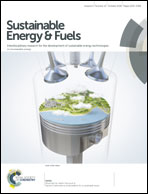Will the competitive future of solid state Li metal batteries rely on a ceramic or a composite electrolyte?†
Abstract
The industrial development of Li metal solid state batteries will be boosted not only by providing highly Li+ conductive electrolyte materials, but also by demonstrating their technical viability in the actual device. For the first time, the electrochemical performances of two different electrolytes, a pure Li7La3Zr2O12 ceramic and a polymer–ceramic composite, are compared in a solid state battery with a Li metal anode and a LiFePO4 cathode. No liquid or gel additive was added to improve the interfacial contacts. The technological viability of these two systems was assessed under realistic cycling conditions with a competitive cathode loading of 1 mA h cm−2. Here, we show promising performances for both electrolytes at 70 °C under slow cycling rates; however, the composite stands out under fast cycling rates due to enhanced interfacial contacts. The energy density of the two systems is compared to the electric vehicle industry targets providing clear specifications for future system development.



 Please wait while we load your content...
Please wait while we load your content...